Background: Global collaborative healthcare and global surgery share a common goal of building capacity and sustainability to improve access to safe, high quality, surgical care through collaborative, transnational approaches. We investigated the surgical specialty resource requirements to support global healthcare collaborations at a leading academic medical center.
Methodology: Data was extracted and analyzed from our global services database for a three-year period (Jan 2013–Dec 2015) to determine total faculty and staff hours and full time equivalent (FTE) utilization. Data was analysed by clinical and non-clinical areas of expertise and further stratified by surgical specialties and compared changes over time.
Results: On average 21,940 hours annually, or 10.55 FTEs of faculty and staff subject matter expert time was required. In total, surgical specialties had an average annual utilization of 3,556 hours or 1.71 FTEs and increased from 0.95 FTEs in 2013 to 2.67 FTEs in 2015 with Thoracic Surgery and Urology having the highest utilization. Surgery’s participation out of all departments grew from 11 to 22% (p < 0.001).
Conclusion: Surgical specialties play a significant role in our model for global collaborative healthcare, providing surgical departments an opportunity to fulfil their academic mission and potentially further the impact of global surgery.
Historically, global collaborations involving academic medical centers (AMCs) in the United States (US) focused on specific diseases and public health issues in less developed countries. Recently, rapid privatization of healthcare systems, economic development, and a shift in the disease burden have led providers in emerging countries to seek partnerships with AMCs with hopes of improving care to its citizens. This new paradigm is termed Global Collaborative Healthcare and is defined as collaborations between healthcare organizations that transcend borders to produce sustainable improvements in the quality, accessibility, and safety of care [1].
These collaborations are designed to leverage US AMC’s extensive expertise in health care delivery while tailoring this knowledge to local needs and culture in a way that advances health care in the region [1,2].
At the same time, global health plays an increasingly crucial role and is a defining issue of the 21st century. Surgery has largely been absent from the global health arena, which is why Paul Farmer called it “the neglected child of global health” in 2008 [3]. This reality has fortunately been changing, exemplified by the launching of the Lancet Commission on Global Surgery in 2014 to develop and gather the information on the state of surgery worldwide, to study the economics of surgical and anaesthesia care delivery, and to develop strategies for improving access [4]. This work as well as the work of other organizations such as the G4 Alliance, American College of Surgeons’ Operation Giving Back, surgical non-governmental organizations, and many others, surgery is now considered an integral part of global health [5,6].
We believe global collaborative healthcare and global surgery share a common goal which is to build capacity and sustainability to improve access to safe, high quality, surgical care through collaborative, transnational approaches. The key tenets of global health address illnesses that are worldwide or universally present, that transverse national boundaries and continents, and that overall synthesize population-based approaches with individualized healthcare [7].
Johns Hopkins Medicine International (JHI) is the institutional platform that facilitates the global expansion of the JHM mission: to improve the health of the community and the world by setting the standard of excellence in medical education, research, and clinical care. Over time, the size and scope of JHI’s engagements have increased, from short term consulting engagements to projects of greater complexity and resource requirements, such as affiliations, clinical operations, hospital management agreements and joint ventures. We sought to investigate and measure the surgical specialty human resource and subject matter expertise to support the JHI operating model for its current portfolio of global collaborations. These resources served as an initial assessment of delivered services as a structure indicator of healthcare quality [8].
Since its inception, JHI has worked in over 50 countries in Asia, North and South America, Europe, the Middle East, and Africa. Currently there are 19 active projects in 16 countries. These collaborations provide a platform on which longitudinal collaborations and interventions can be implemented. In order to deliver on our projects, JHI engages a wide range of subject matter experts (SMEs) from the entities that comprise Johns Hopkins Medicine (JHM) and Johns Hopkins University. These experts provide assistance to JHI’s partner institutions to shape strategy, be catalysts for change, and deliver knowledge transfer including assessments, development of plans and implementation for new or enhancement of clinical or administrative services, clinical rotations, observer ships, workshops, courses, and conferences provided at either partner facilities or Johns Hopkins entities in the US to create sustainable improvements in care delivery.
Work orders and down streaming
In order to facilitate and monitor the use of SMEs, JHI develops work orders, which are standardized contractual agreements that define the services to be provided (resource need), including resource requirements such as subject matter expertise, number of personnel, composition of multidisciplinary teams, when necessary, objectives and deliverables, timelines, time commitment, payment and additional terms and responsibilities (Figure 1). These work orders are executed and retained in the JHI Global Services database. Global Services maintains this database, which interfaces with financial systems, to facilitate the work of the regional project teams and core support functions. These functions include invoicing, generation of project profit loss statements and payments to JHM entities and JHU schools and departments, which is referred to as downstream. Requests for downstream payments are entered by JHI Global Services staff and processed by Finance upon completion of the defined deliverable.
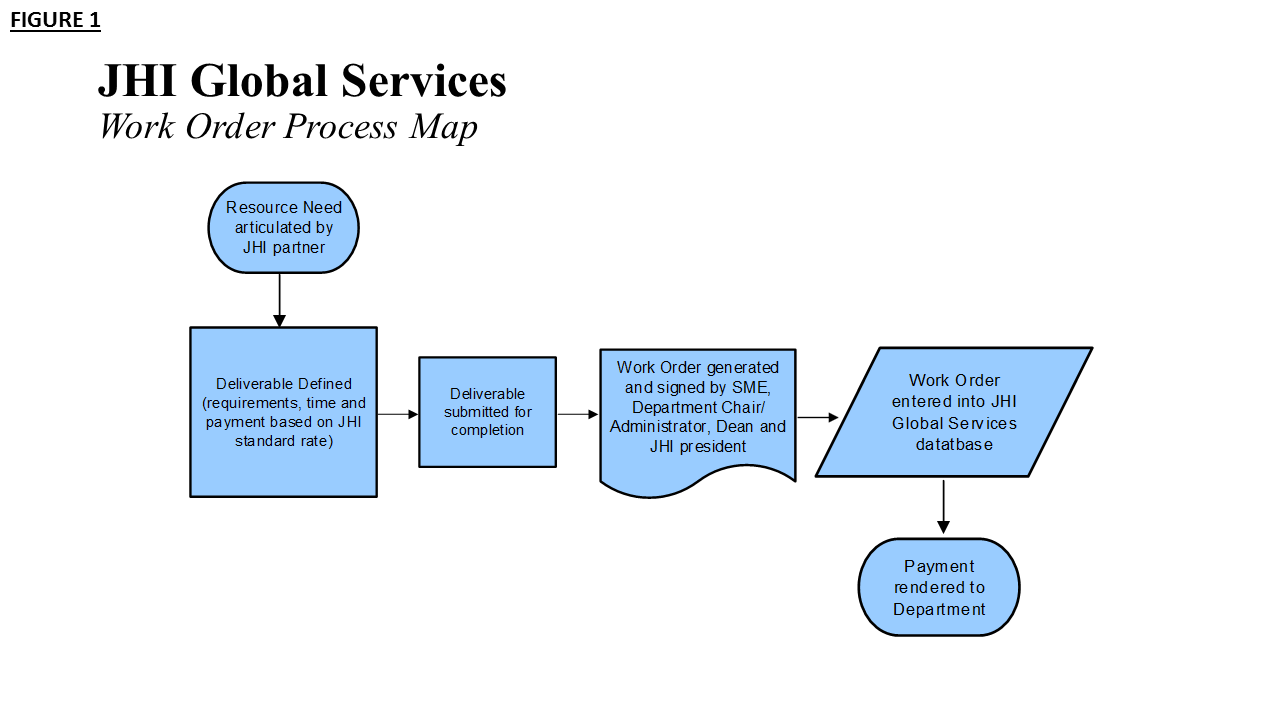
Figure 1. Depiction of the JHI work order process, which are standardized contractual agreements that define the services to be provided, including objectives and deliverables, timelines, time commitment, payment and additional terms and responsibilities
Data analysis
We extracted data from the JHI Global Services Database based on a query for all downstream payments that were processed upon completion of requested work for 36 months between January 2013 and December 2015. We sorted and analyzed data by a number of variables:
1) Total Utilization (hours and full time equivalent (FTE)) and 2) and clinical and non-clinical areas of expertise. Using the American College of Surgeons definition, we reviewed 14 surgical specialties [9]. In addition, we sorted and totalled all activities by the type of work including quality and safety, gap assessment and due diligence, clinical program development, education and training.
For purposes of this analysis, 1 FTE = 2,080 hours and the standard JHI Global Services consulting rates for physicians, nurses, administrators and other staff were used for the conversion. This includes all work performed on behalf of JHI Global Services and excludes work performed relating to direct patient care provided overseas or in the US.
Statistical analysis
We used Stata v13.1 (StataCorp LP, College Station, TX) and Microsoft Excel (Microsoft Corp, Redmond, WA) for descriptive analysis. We summarized continuous variables using means and standard deviations or medians and interquartile ranges, as appropriate, and categorical variables using proportions.
Between December 2013 and January 2015, 21,940 hours annually, or 10.55 FTEs of faculty and staff SME time were required for our global collaborations. Of JHI’s 19 active collaborations, 13 projects had areas of focus which involved surgical specialties (Figure 2).
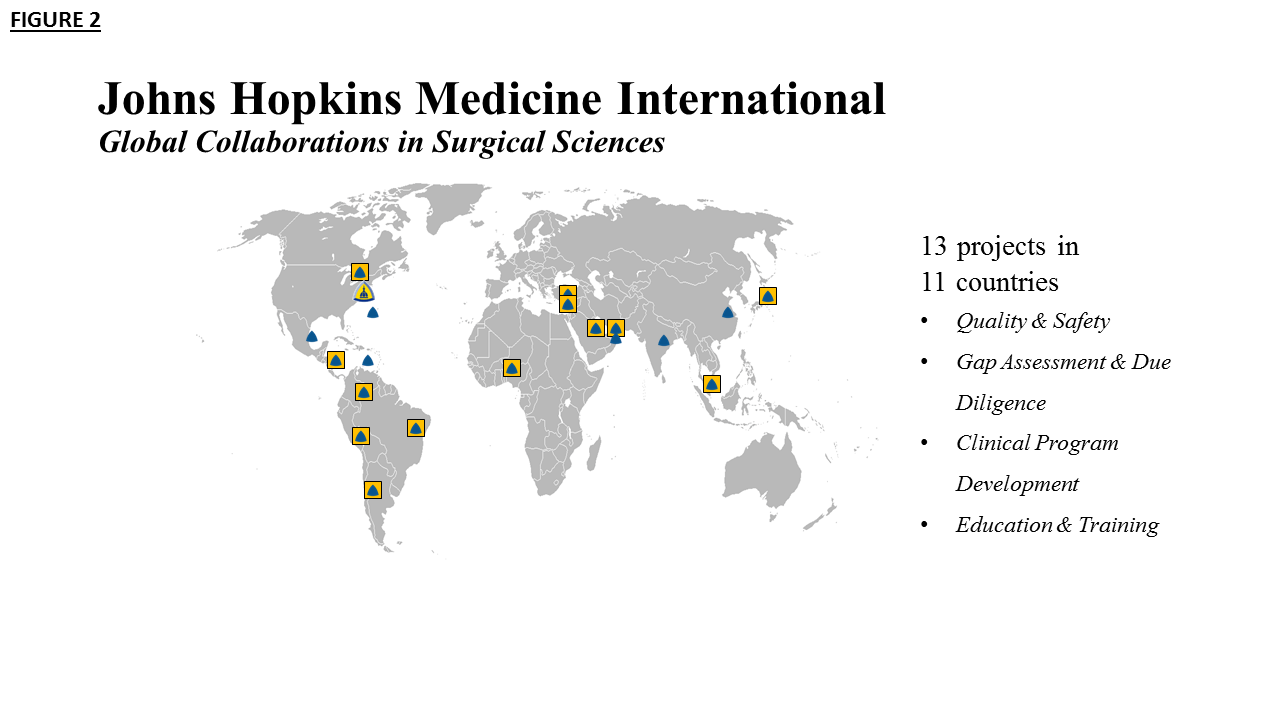
Figure 2. Depiction of Johns Hopkins Medicine International’s (JHI) global footprint for collaborations, 13 of which, highlighted in orange, have areas of focus which involve surgical specialties. The type of work includes quality and safety, gap assessment and due diligence, clinical program development, education and training.
In terms of distribution by department, the Department of Medicine had the highest annual utilization at the beginning of the study period, representing 35.4% of the total, followed by other clinical (25.6%), nursing and allied health departments (14.2%), Surgery (9.4%), and non-clinical departments, schools and institutes (7.5%) (Figure 3). This distribution changed over time, as the total number of hours provided by Surgery increased by 92% annually, while other departments increased on average by 9% annually. These differences were statistically significant (p < 0.001). At the end of our study period (CY2015), non-clinical departments, schools and institutes had the highest participation (33.4%), followed by Surgery (22.4%), other clinical (17.45%), Medicine (17.44%), and nursing and allied health departments (14.8%).
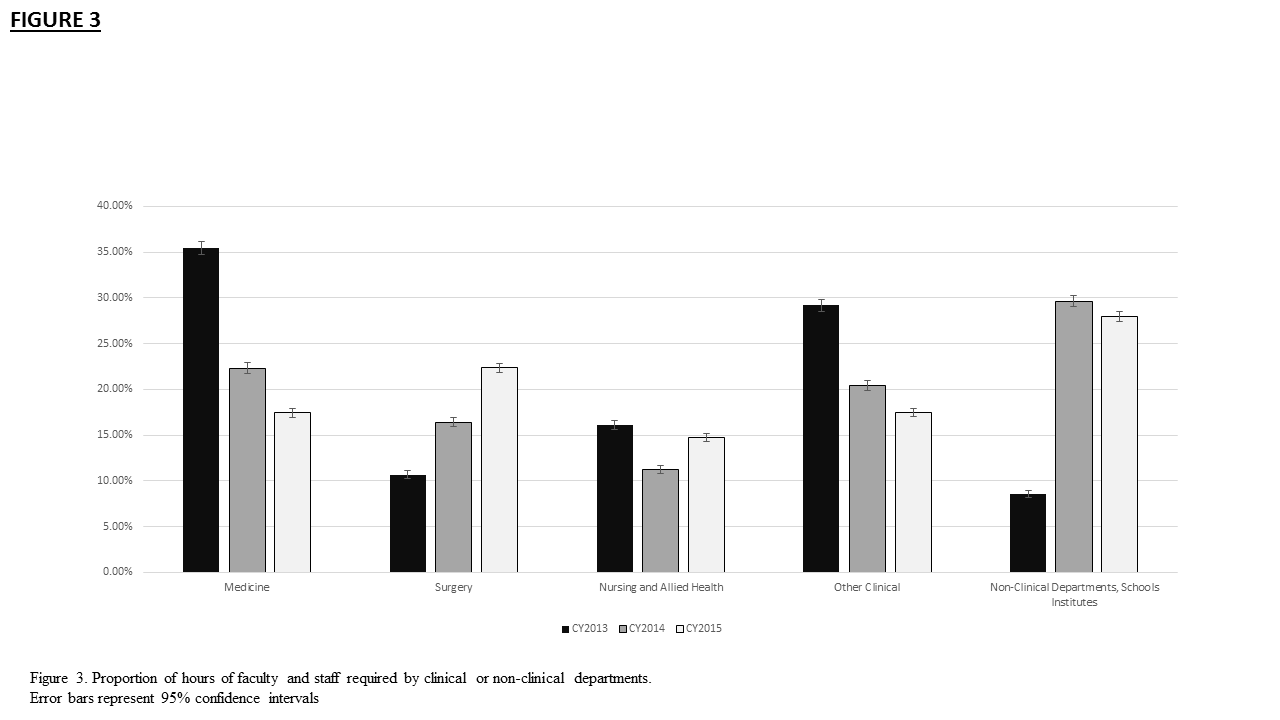
Figure 3. Proportion of hours of faculty and staff required by clinical or non-clinical departments. Error bars represent 95% confidence intervals
When analysing within surgery, by the fourteen ACS-defined surgery specialties, the specialties with the highest average utilization were thoracic and urology, with an annual average of 673 hours (18%) and 582 hours (15.5%) respectively, followed closely by neurosurgery (14.9%) and vascular surgery (11.4%) (Figure 4). However, the subspecialties with greatest increase in utilization over the study period were colorectal surgery (increasing 8-fold from CY2014 to CY2015), followed by plastic and maxillofacial surgery and orthopaedic surgery, both approximately increasing 3-fold between CY2013 to CY2015.
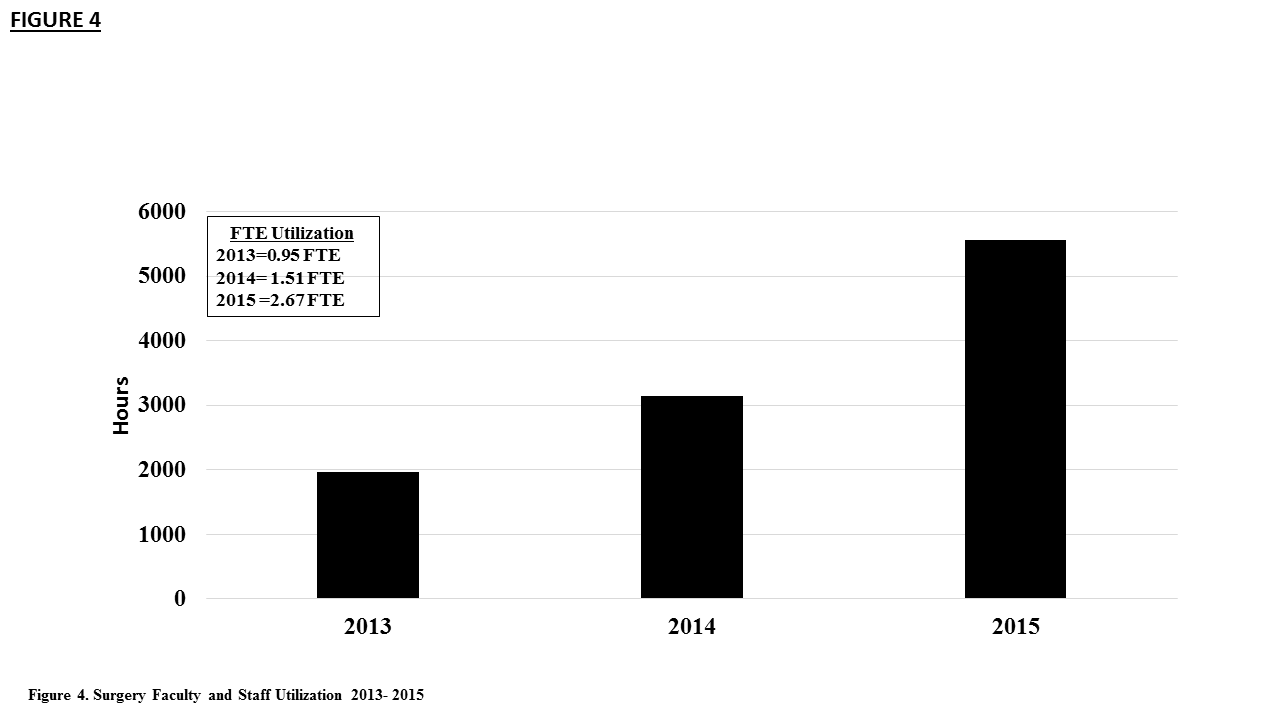
Figure 4. Total surgical specialty faculty and staff utilization by calendar year (CY) for 2013–2015.
The hours of total utilization of surgery faculty and staff for each of the three years were 0.95 FTEs in 2013, 1.51 FTEs in 2014, and 2.7 FTEs in 2015 (Figure 5). A large majority of the hours were provided by physicians (78%), as compared to nursing and allied health professionals (17%), and administrative staff (5%). This distribution remained stable over the 3 years.
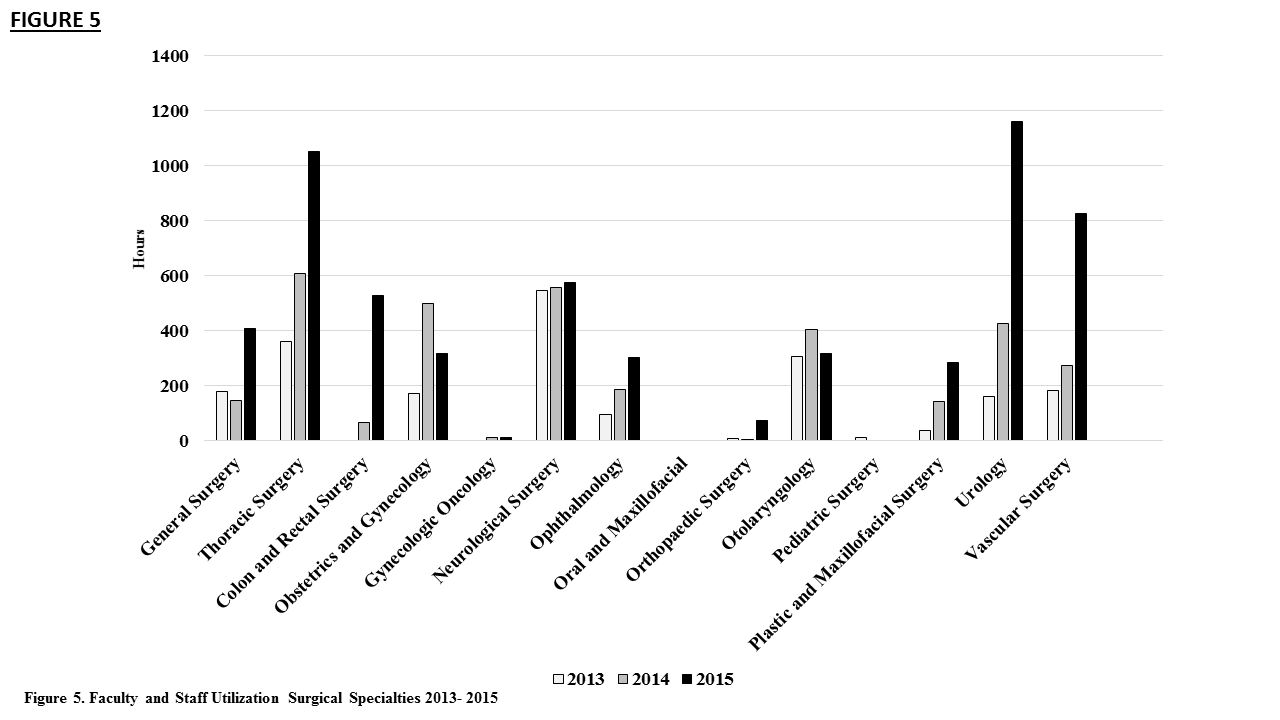
Figure 5. Annual utilization trends of ACS surgical specialty for 2013 -2105.
Throughout the 3 years covered in this study, the number of hours of utilization represented by surgical specialties increased almost 3-fold (92% annually). This increase appears to have occurred primarily as a result of a larger number of services provided, rather than recruitment of a larger pool of providers which, in turn, increased by only 21% annually.
The most common type of work was quality and safety (36.8%), followed by clinical program development (34.5%), gap assessment and due diligence (16.6%), and education and training (12%). The fastest growing type of service was clinical program development, with an average annual increase of 286.4% total hours, followed by education and training (140.1% annual increase), quality and safety (55.7% annual increase), and gap assessment and due diligence (10.3% annual increase).
US AMCs have long played a critical role in healthcare, with their innovation, discovery and academic pursuits transforming the standard of care at home and abroad [10]. Currently, the global healthcare market is rapidly developing, providing a platform for AMCs to enter into collaborative partnerships with international healthcare organizations around the world, and providing a means for AMCs to deliver on its promise globally while also expanding and diversifying resources helping to continue to fulfil its mission in the US. JHI has been at the forefront of global collaborative healthcare, but the model remains under development, evaluation, and refinement [11].
In evaluating the resource requirements to support the global portfolio of projects at a leading US AMC, we found that an average 21,940 hours of subject matter expertise was required over a three-year period. Our findings document an increasing involvement of surgical services among the global collaborative partnerships leveraged by JHI; 17.1% of total hours of surgical specialty expertise was required and surgery specialties experienced an increase over the three years studied. This increase, which was ten times faster relative to its baseline over this 3-year study period, compared to the rest of the departments, suggests that the steadily increasing role for surgical specialties in global health [6] is paralleled in global collaborative healthcare as well. The most commonly provided service in our study was in quality and safety of health services. The type of service that grew the fastest was clinical program development. These two types of services contribute to the strengthening of existing surgical systems, which is essential in improving the quality of healthcare provided in health systems worldwide and successfully reaching the 2030 sustainable development goals [12].
Historically, many efforts in global surgery have been identified with short term medical missions in which healthcare teams travelled to low- or middle-income countries to provide surgical care. There has been debate about the absence of standardized evaluation of these efforts as well as the impact and the overall sustainability of these medical missions [13,14]. Over the past decade, there has been increased recognition of the vital role surgery plays in global health [15]. This recognition is exemplified by the launching of the Lancet Commission on Global Surgery in 2014, the World Health Organization making surgical care a priority through its Programme for Emergency and Essential Surgical Care (EESC) and the work of many surgeons who have dedicated their careers to academic and non-academic global surgery and of organizations such as the G4 Alliance, Operation Giving Back, part of the American College of Surgeons, surgical non- governmental organizations, and many others [5,6]. These organizations have worked to define global surgery, and to systematically quantify 1) the burden of disease requiring surgical care, 2) the population lacking access to safe surgical care, and 3) the economic impact. Just as important, they have also dispelled misconceptions such as surgery inequity only being an issue in low- income or middle-income countries or that investing in surgery is not cost-effective to improve population health [7,15].
While US AMCs have employed different models to engage in global collaborative healthcare, we believe global collaborative healthcare, which typically involves longitudinal engagements, can serve as a platform for the advancement of the key tenets of global surgery initiatives, and that jointly, capacity and sustainability can be built to improve access to safe, high quality, surgical care. For some institutions, there is a long-standing concern about the potential inability to successfully engage in international activities coupled with the potential to drain resources and divert the focus from the AMCs’ core mission at home. This is certainly a potential risk if there is not sufficient redundancy or elasticity in an organization’s bandwidth. It can be argued that the positives, including the ability to improve the health of millions and expanding collaborative opportunities into the realm of research or education, for example, far outweigh the negatives [16]. In our study, we found that the dramatic increase that was achieved in resource utilization was primarily due to an increase of the frequency and duration of the services delivered, rather than by increasing the number of providers involved. This suggests that the AMC’s global mission benefited from increased resources from a pool of committed providers instead of diverting significant resources from the home mission.
Our evaluation of resource requirement has limitations in that it does not necessarily reflect the true demand for surgical specialty expertise as the JHI model, rather the demand that JHI is able to meet or supply resources for, does not proactively seek projects or engagements within defined specialties and is therefore generally reactive as it works to meet the needs of existing partner. Another limitation is the retrospective nature and the relatively limited study duration.
Surgical specialties play a critical role in JHI’s global collaborations, increasing over the three years studied, reflecting the increasing importance that JHI’s partners place on developing or enhancing surgical services within their hospitals. Engaging in these collaborations may be a vehicle for AMC’s to improve access and quality of care globally. These global collaborations can be viewed by departments and surgeons as opportunities to further the academic mission and by extension of global surgery.
- Thompson S (2014) Getting on the Map Baltimore. Available from: http://www.hopkinsmedicine.org/news/publications/global_collaborative_healthcare
/files/sebindoc/c/g/D0EFC5221A78A9CEAA2CA2602AF31579.pdf.
- Merritt MG Jr, Railey CJ, Levin SA, Crone RK (2008) Involvement abroad of U.S. academic health centers and major teaching hospitals: the developing landscape. Acad Med 83: 541-9. [Crossref]
- Farmer PE, Kim JY (2008) Surgery and global health: a view from beyond the OR. World J Surg 32: 533-536. [Crossref]
- Pope R, Shaker M, Ganesh P, Larkins-Pettigrew M, Pickett SD (2016) Barriers to Global Health Training in Obstetrics and Gynecology. Ann Glob Health 82: 625-629. [Crossref]
- Ng-Kamstra JS, Riesel JN, Arya S, Weston B, Kreutzer T, et al. (2016) Surgical Non- governmental Organizations: Global Surgery's Unknown Nonprofit Sector. World J Surg 40: 1823-41. [Crossref]
- Meara JG, Greenberg SL (2015) Global surgery as an equal partner in health: no longer the neglected stepchild. Lancet Glob Health 3: S1-2. [Crossref]
- Dare AJ, Grimes CE, Gillies R, Greenberg SL, Hagander L, et al. (2014) Global surgery: defining an emerging global health field. Lancet 37: 2245-2247. [Crossref]
- Donabedian A (1988) The quality of care. How can it be assessed? JAMA 260: 1743-1748. [Crossref]
- American College of Surgeons. What are the surgical subspecialties? Available from: https://www.facs.org/education/resources/medical-students/faq/specialties.
- Hill LD, Madara JL (2005) Role of the urban academic medical center in US health care. JAMA 294: 2219-2220. [Crossref]
- Thompson SJ (2012) The perils of partnering in developing markets. Harv Bus Rev 90: 23-25. [Crossref]
- Ahmed F, Michelen S, Massoud R, Kaafarani H (2016) Are the SDGs leaving safer surgical systems behind? Int J Surg 36: 74-75. [Crossref]
- Maki J, Qualls M, White B, Kleefield S, Crone R (2008) Health impact assessment and short-term medical missions: A methods study to evaluate quality of care. BMC Health Serv Res 8: 121. [Crossref]
- Humphries, Courtney. Surgery for All. Harvard Magazine. Boston, Massachusetts. July - August 2015.
- Johnson WD (2013) Surgery as a Global health issue. Surg Neurol Int 4: 47. [Crossref]
- Kanter SL (2010) International collaborations between medical schools: what are the benefits and risks? Acad Med 85: 1547-1548. [Crossref]





